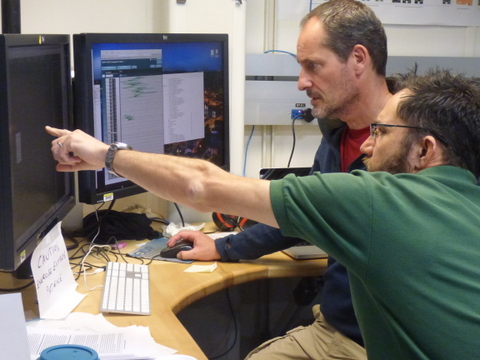
Stratigraphic Correlation, also known as “wiggle matching”
Since there is a working plan for filling the gaps, the stratigraphic correlators are doing a bit better today, so continuing on our path following the core…
Along with the data collected by Jens and Lathika (Friday’s blog), the whole round core gets put into the NGR to measure Natural Gamma Radiation from its clay minerals. These measurements get translated into wiggles with identifiable patterns. Remember that the entire purpose of the drilling is to get a complete record of earth’s climates in the past 5-6 million years in the form of a continuous sediment column ~300m deep, but we can only do it 9.5m at a time, and it’s all happening 3000m below at the bottom of the ocean. After the 30+ cores are collected from Hole A, the ship moves over a small distance and they drill in Hole B. The stratigraphic correlators then try to line up all the identifying wiggles along the column, and identify gap areas that need to be filled in by adjusting the core heights for Hole C.
The analogy I like to use is imagine you are standing in a field of wildflowers with mountains all around you, and you want to take a panoramic photo to show all of nature in its glory. So you take a series of photos as you turn a full circle, and then you paste all of the photos together. You realize that you are missing the top of one of the mountain peaks in one view, the purple flowers over by the stream got left out, and the craggy old tree is missing a few of its limbs, so you take a few more photos to fill in what you missed. Now you have a complete panoramic view.
This is basically what the stratigraphic correlators are doing, but their mountain peaks and flowers are wiggly lines of data reaching back in time.